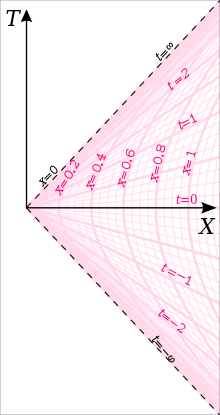
A | B | C | D | E | F | G | H | CH | I | J | K | L | M | N | O | P | Q | R | S | T | U | V | W | X | Y | Z | 0 | 1 | 2 | 3 | 4 | 5 | 6 | 7 | 8 | 9
Rindler coordinates are a coordinate system used in the context of special relativity to describe the hyperbolic acceleration of a uniformly accelerating reference frame in flat spacetime. In relativistic physics the coordinates of a hyperbolically accelerated reference frame[H 1][1] constitute an important and useful coordinate chart representing part of flat Minkowski spacetime.[2][3][4][5] In special relativity, a uniformly accelerating particle undergoes hyperbolic motion, for which a uniformly accelerating frame of reference in which it is at rest can be chosen as its proper reference frame. The phenomena in this hyperbolically accelerated frame can be compared to effects arising in a homogeneous gravitational field. For general overview of accelerations in flat spacetime, see Acceleration (special relativity) and Proper reference frame (flat spacetime).
In this article, the speed of light is defined by c = 1, the inertial coordinates are (X, Y, Z, T), and the hyperbolic coordinates are (x, y, z, t). These hyperbolic coordinates can be separated into two main variants depending on the accelerated observer's position: If the observer is located at time T = 0 at position X = 1/α (with α as the constant proper acceleration measured by a comoving accelerometer), then the hyperbolic coordinates are often called Rindler coordinates with the corresponding Rindler metric.[6] If the observer is located at time T = 0 at position X = 0, then the hyperbolic coordinates are sometimes called Møller coordinates[1] or Kottler–Møller coordinates with the corresponding Kottler–Møller metric.[7] An alternative chart often related to observers in hyperbolic motion is obtained using Radar coordinates[8] which are sometimes called Lass coordinates.[9][10] Both the Kottler–Møller coordinates as well as Lass coordinates are denoted as Rindler coordinates as well.[11]
Regarding the history, such coordinates were introduced soon after the advent of special relativity, when they were studied (fully or partially) alongside the concept of hyperbolic motion: In relation to flat Minkowski spacetime by Albert Einstein (1907, 1912),[H 2] Max Born (1909),[H 1] Arnold Sommerfeld (1910),[H 3] Max von Laue (1911),[H 4] Hendrik Lorentz (1913),[H 5] Friedrich Kottler (1914),[H 6] Wolfgang Pauli (1921),[H 7] Karl Bollert (1922),[H 8] Stjepan Mohorovičić (1922),[H 9] Georges Lemaître (1924),[H 10] Einstein & Nathan Rosen (1935),[H 2] Christian Møller (1943, 1952),[H 11] Fritz Rohrlich (1963),[12] Harry Lass (1963),[13] and in relation to both flat and curved spacetime of general relativity by Wolfgang Rindler (1960, 1966).[14][15] For details and sources, see § History.
Characteristics of the Rindler frame

The worldline of a body in hyperbolic motion having constant proper acceleration in the -direction as a function of proper time and rapidity can be given by[16]
where is constant and is variable, with the worldline resembling the hyperbola . Sommerfeld[H 3][17] showed that the equations can be reinterpreted by defining as variable and as constant, so that it represents the simultaneous "rest shape" of a body in hyperbolic motion measured by a comoving observer. By using the proper time of the observer as the time of the entire hyperbolically accelerated frame by setting , the transformation formulas between the inertial coordinates and the hyperbolic coordinates are consequently:[6][9]
-
(1a)
with the inverse
Differentiated and inserted into the Minkowski metric
the metric in the hyperbolically accelerated frame follows as
-
(1b)
These transformations define the Rindler observer as an observer that is "at rest" in Rindler coordinates, i.e., maintaining constant x, y, z, and only varying t as time passes. The coordinates are valid in the region , which is often called the Rindler wedge, if represents the proper acceleration (along the hyperbola ) of the Rindler observer whose proper time is defined to be equal to Rindler coordinate time. To maintain this world line, the observer must accelerate with a constant proper acceleration, with Rindler observers closer to (the Rindler horizon) having greater proper acceleration. All the Rindler observers are instantaneously at rest at time in the inertial frame, and at this time a Rindler observer with proper acceleration will be at position (really , but we assume units where ), which is also that observer's constant distance from the Rindler horizon in Rindler coordinates. If all Rindler observers set their clocks to zero at , then when defining a Rindler coordinate system we have a choice of which Rindler observer's proper time will be equal to the coordinate time in Rindler coordinates, and this observer's proper acceleration defines the value of above (for other Rindler observers at different distances from the Rindler horizon, the coordinate time will equal some constant multiple of their own proper time).[18] It is a common convention to define the Rindler coordinate system so that the Rindler observer whose proper time matches coordinate time is the one who has proper acceleration , so that can be eliminated from the equations.
The above equation has been simplified for . The unsimplified equation is more convenient for finding the Rindler Horizon distance, given an acceleration .
Antropológia
Aplikované vedy
Bibliometria
Dejiny vedy
Encyklopédie
Filozofia vedy
Forenzné vedy
Humanitné vedy
Knižničná veda
Kryogenika
Kryptológia
Kulturológia
Literárna veda
Medzidisciplinárne oblasti
Metódy kvantitatívnej analýzy
Metavedy
Metodika
Text je dostupný za podmienok Creative
Commons Attribution/Share-Alike License 3.0 Unported; prípadne za ďalších
podmienok.
Podrobnejšie informácie nájdete na stránke Podmienky
použitia.
www.astronomia.sk | www.biologia.sk | www.botanika.sk | www.dejiny.sk | www.economy.sk | www.elektrotechnika.sk | www.estetika.sk | www.farmakologia.sk | www.filozofia.sk | Fyzika | www.futurologia.sk | www.genetika.sk | www.chemia.sk | www.lingvistika.sk | www.politologia.sk | www.psychologia.sk | www.sexuologia.sk | www.sociologia.sk | www.veda.sk I www.zoologia.sk























